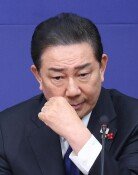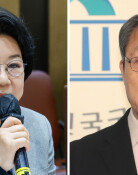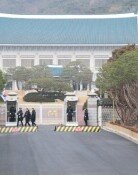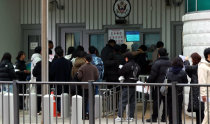Building Wrap Ads Cover Seoul Skyline
Building Wrap Ads Cover Seoul Skyline
Posted June. 12, 2006 03:46,
People passing in front of the Dong-A Media Center at the crossroads of Sejong-ro, Jongno-gu, Seoul stare at the exterior of the building. A gigantic picture of Park Ji-sung (Manchester United), a soccer player of the Korean national soccer team, kicking off a dynamic shot, is posted on the walls.
With a width of 50m, and a length of 62m and covering the Dong-A Media Center from the 5th to the 19th floor, the picture is made from mesh material. With numerous holes, the soccer players clothing is also made of this material.
Baek Eun-gyeong, PR team leader of Nike Korea, which produced this ad, said It took almost one month to produce this material, with 12 days to print the picture on 42 pieces of material, and linking the pieces together through a high-frequency attachment method.
Along with the Dong-A Media Center, other buildings around Gwanghwamun, including Kyobo Life, Shinsegae, Shinhan Bank, and SK Telecom as well as major buildings near the Seoul City Hall are wrapped with ads that encourage the Korean team participating in the World Cup.
Advertising Effects-
Wrapping advertisements are done by wrapping the surface of walls, columns, or cars with printed material. Among these building wraps are done by covering the surface of buildings with paper, cloth, or coated material.
There are four types of building wrap. The most common are hanging curtains, and a stronger version is NECO. Almost all wrapping ads on the Gwanghwamun area, including the Kyobo Life building, are printed on NECO.
The building wrap made of mesh over the Dong-A Media Center is slightly less clear, but unlike NECO, those inside the building can see out, and the material is of a higher quality. The last is a special film made of photographs.
The special film is the most expensive, followed by mesh, NECO, and hanging curtains.
The production fees of a building wrap vary according to material and size. NECO costs 40 to 50 thousand won per square meter, while mesh costs 45 to 55 thousand won.
The mesh material that comprises the building wrap on the Dong-A Media Center cost a total of 130 million won, while the NECO building wrap on the Samsung Main Building 33m by 50m cost approximately 80 million won.
In Korea, around 10 major billboard manufacturers, such as Kochiam, Seoin, Geundo, and a number of small and medium companies are manufacturing wrapping advertisements.
Starting Off From the 2002 Korea-Japan World Cup-
When did wrapping ads that cover Koreas buildings start?
Ad agencies state that Prime Group was the first to use this method through the 202m Technomart building located at Gueui-dong, Gwangjin-gu, Seoul.
Prime Group produced a series of slogans for national integration, and after the Asian financial crisis they came up with slogans like Uratchacha (cheering shout) in 1999; A Nation in the Center of the World in the New Millennium; Embracing Each Other in 2001; and Dae~hanminguk (the Republic of Korea) this year.
The 2002 Korea-Japan World Cup kicked off the domestic wrapping ad industry.
At the time, the windows of the Trade Center building located at Samseong-dong, Gangnam-gu, Seoul were posted with a 130m-tall and 52m-wide building wrap by KT made with 1600 pieces of special film. Later it was recorded in the Guinness Book as the worlds largest building wrap.
With the 2006 World Cup in Germany, the renewed building wrap ads are projected to have a great influence in the advertising industry.
Lee Haeng-ryul, director of the SP Media Project team of Cheil Communications Co., said Building wraps dont have a size limit, and its exposure and impact are high, and that the ad industry is greatly expectant of this, with the relaxing of regulation on outdoor ads.
In Hong Kong and Japan where wrapping ads are the norm, building wraps also contribute to urban design.
Sang-Soo Kim ssoo@donga.com




![[사설]“용인에 産團 있어야 할지”… 국가대계 흔드는 경망한 김성환](https://dimg.donga.com/c/138/175/90/1/wps/NEWS/IMAGE/2025/12/28/133051638.1.jpg)


